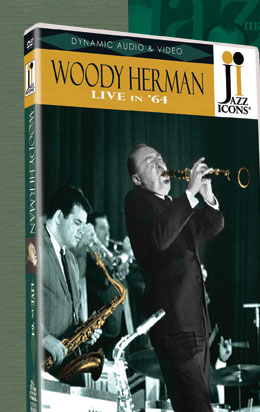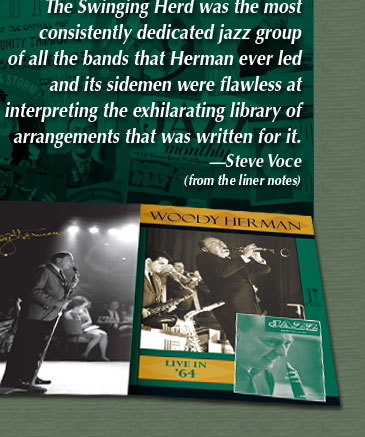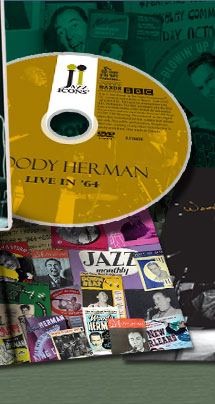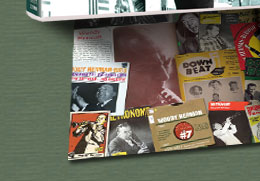




 |
 |
|
|||
|
|
|
||||
|
|
|
||||
|
|
|
||||
|
|
|
||||
 |
|
||||
 |
|
||||
 |
|
||||
|
|
|
|
|
|
|
Jazz Icons: Woody Herman features a blistering one-hour concert from 1964 showcasing one of the very hottest line-ups of the “Swinging Herd,” including trumpeter Bill Chase, trombonist Phil Wilson and the amazing saxophonist Sal Nistico on the front line, as well as drummer Jake Hanna, bassist Chuck Andrus and pianist-arranger Nat Pierce in the rhythm section. Woody and his band roar throughout the entire show which includes standards such as “Lonesome Old Town’ and “After You’ve Gone” as well as new originals including Charles Mingus’s “Better Git It In Your Soul.” |
|
 |
|
|
|
|
20-page booklet Liner notes by Steve Voce Cover photo by Guy LeQuerrec Booklet photos by Lee Tanner, Jan Persson, Herb Snitzer Memorabilia collage Total time: 60 minutes |
|
|
Sample Liner Notes by Steve Voce: Phil Wilson was a trombone virtuoso. He had the most developed technique of his day on the instrument. He was already immersed in efforts to “vocalise” the trombone – he believed that it should reflect the human voice in the way that the work of trombonist Vic Dickenson did. His phenomenal dexterity with lip and slide was unmatched and was to prove a spectacular weapon in the band’s armoury. Wilson had worked on the rotary breathing technique first developed by the Ellington baritone sax player Harry Carney. This involved breathing in through the nose while keeping up a pressure in the mouth, enabling him to blow a note at the same time. In this way, he was able to hold notes indefinitely or construct long phrases without appearing to draw breath. Joining Wilson in the trombone section was one of his disciples, Henry Southall, a delightful eccentric and a potent soloist who was perhaps inevitably cast in the shadow of Wilson. Ever unorthodox and original, Southall evoked more of the shaggy dog Herman tradition of Bill Harris trombone than did Wilson. Another virtuoso was a tenor player and some time builder’s labourer named Salvatore Nistico. As you’ll see when you watch him, he had muscle-bound lips and an embouchure of iron. He played with a rock-steady swing whatever the tempo and, like Wilson, he had lightning articulation. Nistico was unfairly slighted by some critics for being all show and no substance, but in fact he was a gifted improviser and an incredible asset for a big band. “Sal Nistico had the best time conception of any musician in my whole experience,” said Herman. “One night on the road,” said Nistico, “Woody pointed at me on ‘Caldonia,’ and I stood up and just played real fast, and he was kind of gassed, and it kept getting faster, and by the time we got to the Metropole, I was doing a 20-minute up-tempo solo on every set. Like it would be ‘Northwest Passage,’ ‘Apple Honey’ and ‘Caldonia.’” All of them staple numbers from the First Herd’s library, of course. On the First Herd’s recording of “Caldonia” in February 1945, the band played at 68 bars a minute, although Chubby Jackson tended to speed up towards the end. But in the Jazz 625 version, the bars fly by at, as near as one can tell, 108 bars a minute. It’s hard to be sure because “Caldonia” is two blues played one after another. If it was a standard 32 bar (8 x 8 x 8 x 8) song it would be possible to count the bars with certainty, but in “Caldonia” Joe Romano in particular eats his solo up at the speed of thought, and it becomes impossible to know where one is in the chorus. ********* JAZZ ME BLUES (Tom Delaney) arranged by Nat Pierce. Pierce went back to the days of Bix Beiderbecke to dig out this unlikely warhorse, written by Tom Delaney in 1921.Romano comes out from the Four Brothers-styled saxophones to show off his hard-attacking style in his solo. His sound has a different concept to the Lestorian inspiration of Herman’s original Four Brothers tenor players, Stan Getz, Zoot Sims and Herbie Steward. The eccentric and here bandy-legged Southall plays a fine solo through his verdigris-encrusted trombone, showing touches of his stylistic roots in the playing of Frank Rosolino. DAYS OF WINE AND ROSES (Johnny Mercer/Henry Mancini) was arranged by Nat Pierce. Woody Herman picks up his alto and plays a creamy theme statement in the manner of the Lily Pons of the alto, Johnny Hodges. Then, unusually, he steps back and plays in the sax section. Hunt plays a lyrical solo with Bobby Hackett overtones. FOUR BROTHERS (Jimmy Giuffre) arranged by Nat Pierce. Gary Klein hews to the cool sound of the original Second Herd tenor players for the 1947 classic, and he’s followed by Anastas on baritone before the tough guys Nistico and Romano take over. The sound of the ensemble, like all the saxophone ensembles in this band, confirm how beautifully voiced and rehearsed this section was, whilst the four and eight bar breaks towards the end show off the dexterity of the individual jazz improvisers, too. All words and artwork on this page ©Reelin' In The Years Productions. Unauthorized use is prohibited.
|
|
Site contents ©Copyright 2009 Reelin' In The Years Productions
Site designed by Tom Gulotta